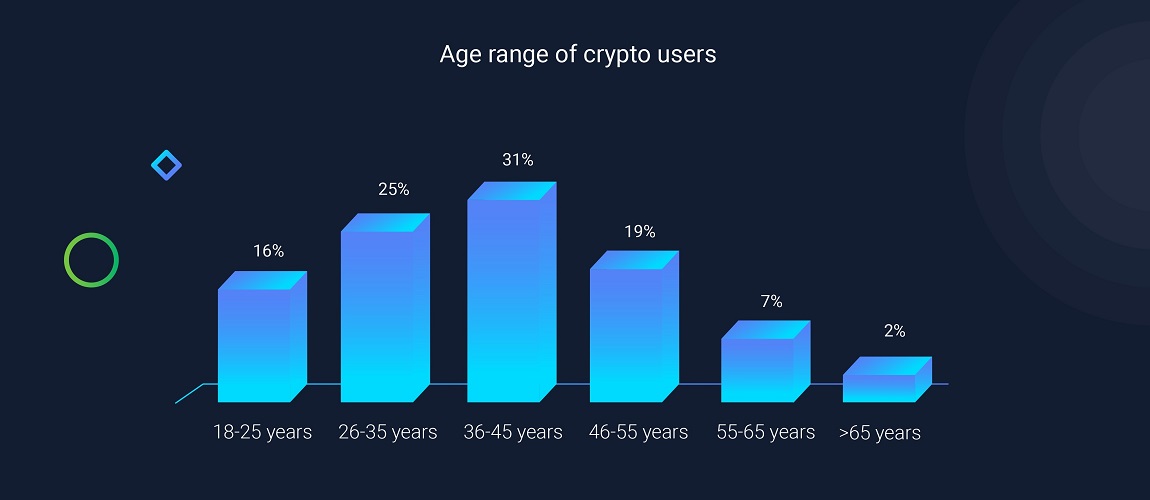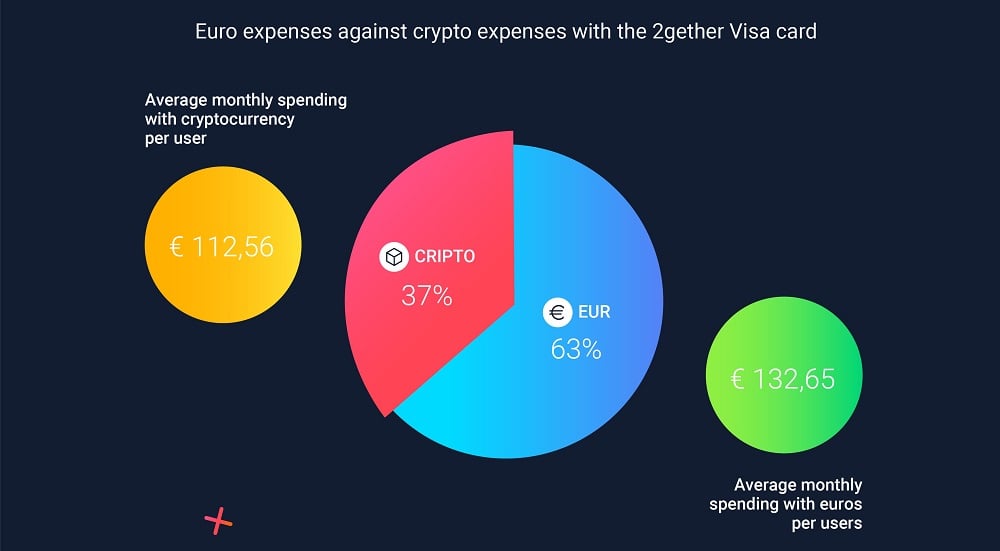Millennial and Male: 3 Crypto Card Issuers Profile Their Average User

Platforms offering debit cards that can be topped up with cryptocurrency have enjoyed growing popularity in the crypto community. They provide a payment solution for those who earn and own digital coins, enabling in-store and online crypto payments. Their expanding user base provides a snapshot of the kind of people who spend crypto on a daily basis and what they like to buy.
Also read: Crypto Debit Card Targets Generation Z With a Promise of Financial Freedom
Highly Educated, Overachieving Foodies
Three European companies with crypto card products shared what they know about their users with news.Bitcoin.com. Madrid-based fintech startup 2gether provides banking services to residents of the Eurozone through its mobile app. The company issues a debit Visa linked to its wallet which supports about a dozen cryptocurrencies. Major ones such as BTC, BCH, ETH, and XRP account for over 90% of the platform’s crypto payments. Its customers can spend them like they would traditional currencies and also withdraw cash at ATMs through conversion to fiat. 2gether recently released statistical data profiling its crypto card users and their spending habits.

The debit card allows holders to pay with cryptos and euros, which 37% and 63% do respectively. The everyday crypto user is a highly educated millennial male, shows the analysis of the spending behavior of more than 10,000 customers. The majority of cryptocurrency spenders, 56%, are between 26 and 45 years old and 77% of them are male. The most common professions among them are lawyers, accountants, and economists (15.64%), followed by students (11.20%), operators and transporters (9.82%), and senior executives and businessmen (8.82%), the company detailed this week.
The study covers a period from April to December 2019 and 19 Eurozone countries where the crypto card is available. It’s mostly used at restaurants and hotels (32.71%), supermarkets and grocery stores (19.13%), and to pay communication bills (11.91%) and transport expenses (11.85%). On average, users spend €112.56 worth of cryptocurrency monthly and €132.65 in fiat. “In comparison with European consumption habits based on euros, the consumption at restaurants and on food receives fourth place in the ranking, with house supplies being the first expense,” 2gether noted, quoting information from Eurostat. CEO Ramon Ferraz further commented:
It is extremely beneficial for us at 2gether to know exactly who our customer is and how they change every year. Our goal is to enable the mass adoption of cryptocurrency and enable users to spend crypto in their everyday life. This data we’ve compiled takes us one step closer to making our goal a reality in 2020.

Bitsa is another European platform striving to provide an alternative to traditional banking. It offers prepaid Visa cards linked to a mobile wallet that can be topped up with cryptocurrencies like bitcoin cash among other payment options. BCH, BTC, LTC, DASH, XLM, XRP, and ZEC can be deposited and converted to euros to spend the balance in stores and online. The Bitsa cards come in virtual and plastic forms and there’s also a product targeting Europe’s Generation Z, Bitsa Young, which allows parents to order a card for their children and provide them with some financial freedom thanks to crypto.
Although it issues its cards through the same partner, the Spanish regulated electronic money institution Pecunpay, Bitsa takes a different approach. The Monaco-based company tracks less card usage data and isn’t very keen on revealing what it knows for a good reason. “We don’t have it because it’s private and we take the privacy of our users very seriously,” CMO Roberta Quintiliano explained. Nevertheless, she was kind enough to pull the curtain a little bit for news.Bitcoin.com and share that the majority of Bitsa users, 74.5%, are aged between 25 and 44 years old and 75.8% are male. The majority of Bitsa card holders are people interested in technologies and mobile applications, she added.
Groceries, Fast Food, Coffee and Travel
A report on crypto card usage in Europe wouldn’t be complete without taking a look at the numbers gathered by a major player. U.K.-based Wirex has over 3 million registered users across 130 countries and has processed more than $3 billion in transactions to date. The platform allows users to spend leading cryptocurrencies such as BTC, LTC, ETH, and XRP among 10 digital coins.
Around 60% of Wirex Visa card users are millennials, aged between 18 and 37, and approximately 39% are members of Generation X, between the ages of 38 and 53 years old, revealed Amelie Arras who is responsible for PR and media communications. An analysis conducted by Wirex in 2018 showed that people choose its platform for the convenience and versatility it offers and because it allows them to pay with either regular fiat currencies or cryptocurrencies.

The service lets crypto enthusiasts exchange their digital currency in-app and spend it anywhere Visa is accepted. Arras also emphasized that “This is reflected in how people use Wirex. It’s particularly suited to those who frequently travel and who therefore want a single place to manage multiple currencies and get the best market rates when exchanging them.” Grocery stores, fast food outlets, coffee shops and travel are at the top of the spending charts for Wirex cards, with a split of roughly 25% online and 75% in-store. Around 80% of account deposits are made in cryptocurrency.
The latest 2019 data available shows that 25% of all currency transactions, fiat and crypto, were recorded in the United Kingdom, followed by Italy with 13%, Spain and Germany with close to 10%, then France with 7%. Around 21% of all crypto to fiat exchanges were made in the U.K., followed by Italy with 14%, Spain and Germany with 10%, and France with 8%. At Wirex, BTC is the most traded coin, representing close to 70% of all crypto conversions, and almost 50% of all currencies, followed by the euro with 20% of all exchanges, then the British pound and ethereum – below 10%. The top five currencies frequently spent by Wirex users, historically and in 2019, are BTC, EUR, GBP, ETH and USD.
What are your thoughts on the data provided by these crypto card issuers? Do you use a debit card that can be topped up with cryptocurrency? Tell us in the comments section below.
Disclaimer: This article is for informational purposes only. It is not an offer or solicitation of an offer to buy or sell, or a recommendation, endorsement, or sponsorship of any products, services, or companies. Bitcoin.com does not provide investment, tax, legal, or accounting advice. Neither the company nor the author is responsible, directly or indirectly, for any damage or loss caused or alleged to be caused by or in connection with the use of or reliance on any content, goods or services mentioned in this article.
Images courtesy of Shutterstock, 2gether.
Do you need a reliable bitcoin mobile wallet to send, receive, and store your coins? Download one for free from us and then head to our Purchase Bitcoin page where you can quickly buy bitcoin with a credit card.
The post Millennial and Male: 3 Crypto Card Issuers Profile Their Average User appeared first on Bitcoin News.
from Bitcoin News https://ift.tt/2tMSMIv
Labels: Bitcoin
0 Comments:
Post a Comment
Subscribe to Post Comments [Atom]
<< Home